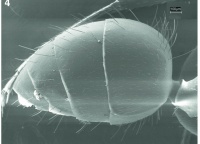Rossomyrmex anatolicus
| Rossomyrmex anatolicus | |
|---|---|

| |
| Scientific classification | |
| Kingdom: | Animalia |
| Phylum: | Arthropoda |
| Class: | Insecta |
| Order: | Hymenoptera |
| Family: | Formicidae |
| Subfamily: | Formicinae |
| Tribe: | Formicini |
| Genus: | Rossomyrmex |
| Species: | R. anatolicus |
| Binomial name | |
| Rossomyrmex anatolicus Tinaut, 2007 | |
Known from type material collected from the Anatolian Plains of Turkey, nothing is known about the biology of Rossomyrmex anatolicus.
Identification
Although it is very similar to Rossomyrmex proformicarum because of the abundant pilosity, it can be distinguished by the petiole, which gradually narrows towards the apex. This character, together with the high number of hairs, can be used to differentiate it from Rossomyrmex minuchae.
Distribution
Distribution based on Regional Taxon Lists
Palaearctic Region: Türkiye (type locality).
Distribution based on AntMaps
Distribution based on AntWeb specimens
Check data from AntWeb
Countries Occupied
| Number of countries occupied by this species based on AntWiki Regional Taxon Lists. In general, fewer countries occupied indicates a narrower range, while more countries indicates a more widespread species. |

|
Estimated Abundance
| Relative abundance based on number of AntMaps records per species (this species within the purple bar). Fewer records (to the left) indicates a less abundant/encountered species while more records (to the right) indicates more abundant/encountered species. |

|
Biology
This species is a dulotic parasite for the ant Proformica korbi (a host) (Tinaut et al., 2010; Ruano et al., 2013; de la Mora et al., 2021).
Castes
Nomenclature
The following information is derived from Barry Bolton's Online Catalogue of the Ants of the World.
- anatolicus. Rossomyrmex anatolicus Tinaut, 2007: 136, figs. 1-4, 10, 11 (w.) TURKEY.
Unless otherwise noted the text for the remainder of this section is reported from the publication that includes the original description.
Description
Worker
Head length: 1.19-1.41 mm; Head width: 1.05-1.22 mm; Occipital width: 0.84-1.00 mm; Scape length: 0.84-0.93 mm; Thorax length: 1.41-1.62 mm. General colour is black or dark brown. The tegument is bright with some ridges in the mesopleuron and metapleuron. There are two types of whitish hairs: very small (about 50 μm) adpressed hairs, and long hairs (about 200 μm) which are abundant on the thorax, petiole and gaster and less abundant on the head.
Long head with sides slightly bowed and with occipital region slightly excised. Slightly marked keel in the front region, the edge of the clypeus is convex and complete, with a small lump on its upper part. Well-developed reddish mandibles with eight teeth, the apical and pre-apical sharper and more developed than the others. Drumstick-like scapes, funiculus with eleven articles, the first being four times longer than its average width and as long as the second and third.
The tegument of the thorax is bright and polished, striated in the pleuron of mesothorax and metathorax only. The entire surface is covered with adpressed hairs and long hairs (around 200 μm), with thirty appearing on the pronotum, a dozen on the mesonotum and epinotum.
High petiole scale narrowing to the apex, where a dozen long hairs appear as well as on both side margins. Oval gaster with numerous hairs all over the dorsal and ventral surfaces.
Type Material
Holotype and type series (19 workers) come from Belembasy Bebi’s harbour (Konya, Turkey), collected the 7 June 2006 at 1340 m altitude, A. Tinaut leg. The holotype and 24 paratype workers are stored in the author’s collection. Two specimens of the paratype series are stored in the collection of the Museo Nacional de Ciencas Naturales of Madrid (Spain) and the Museum of Geneva (Switzerland) besides two other specimens stored in Dra. Dolores Martínez (Univ. Complutense, Madrid, Spain) and Dr. Aktac (Anatolia, Turkey) private collections.
Etymology
The name is dedicated to the region of Anatolia (Turkey).
References
- Tinaut, A. 2007. A new species of the genus Rossomyrmex Arnoldi, 1928 from Turkey. Graellsia 63: 135-142.
- Borowiec, L. 2014. Catalogue of ants of Europe, the Mediterranean Basin and adjacent regions (Hymenoptera: Formicidae). Genus (Wroclaw) 25(1-2): 1-340.
- de la Mora, A., Sankovitz, M., Purcell, J. 2020. Ants (Hymenoptera: Formicidae) as host and intruder: recent advances and future directions in the study of exploitative strategies. Myrmecological News 30: 53-71 (doi:10.25849/MYRMECOL.NEWS_030:053).
- Kiran, K., Karaman, C. 2020. Additions to the ant fauna of Turkey (Hymenoptera, Formicidae). Zoosystema 42(18), 285-329 (doi:10.5252/zoosystema2020v42a18).
- Ruano, F., Sanllorente, O., Lenoir, A., Tinaut, A. 2013. Rossomyrmex, the slave-maker ants from the arid steppe environments. Psyche: A Journal of Entomology 2013, 1–7 (doi:10.1155/2013/541804).
References based on Global Ant Biodiversity Informatics
- Ruano F., O. Sanllorente, A. Lenoir, and A. Tinaut. 2013. Rossomyrmex, the slave-maker ants from the arid steppe environments. Psyche Article ID 541804, 7 pages.
- Sanllorente O., P. Lorite, F. Ruano, T. Palomeque, and A. Tinaut. 2017. Phylogenetic relationships between the slave-making ants Rossomyrmex and their Proformica hosts in relation to other genera of the ant tribe Formicini (Hymenoptera: Formicidae). J Zool Syst Evol Res. 1–13.
- Tinaut A., F. Ruano, O. Sanllorente, A. Fernandez-Zambrano, C. Karaman, and Y. Kaz. 2010. Nest composition and worker relatedness in three slave-making ants of the genus Rossomyrmex Arnoldi and their Proformica Ruzsky hosts (Hymenoptera, Formicidae). Insect Science 17: 361-368.


